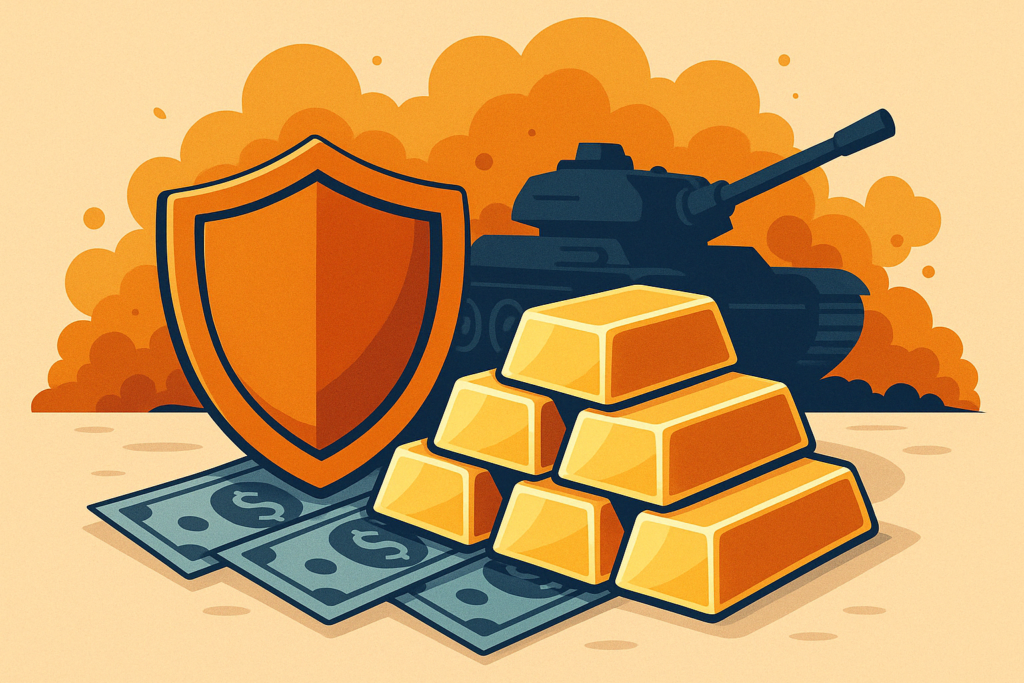In times of geopolitical uncertainty, such as those marked by armed conflicts (or, as in this period, by Trump's macroeconomic declarations), the question of How to protect your savings in case of war (also understood as war on an economic level) becomes crucial for many savers. Personal financial stability can be severely challenged by war events that affect the global economy, financial markets and currency values.
Let's see what can happen and how to protect ourselves 😎

💣 FIAT Currency and War: Why Your Money Loses Value (and May Be at Risk)
In an unstable global context, where the spectre of war is increasingly looming in the headlines, it is not just physical security that is at stake… but also financial security.
And the first question to ask yourself is: Is your money really safe in the bank?
⚠️ Spoiler: no, I'm not. And I'll tell you why 😉
War is, by definition, an accelerator of economic crisis. Governments must finance military spending, support domestic markets, and respond to energy and food supply shocks.
How do they do it?
👉 By printing more money.
👉 Increasing the debt.
👉 Taking extraordinary measures, even on citizens' accounts.
And this is where the FIAT currency, the one we use every day (euro, dollar, yen…).
🏦 Why then does FIAT currency devalue? (especially in times of war)
There FIAT currency is not tied to anything tangible like gold. Its value depends on the trust people (and markets) have in governments and central banks. But when the world is in chaos, that trust collapses.
Here's what happens during (or just before) a war:
- Inflation out of control
With supply chains broken and production slowing, prices skyrocket. The money you have in the bank it's worth less every day that passes.
- Issuing money to finance the conflict
Central banks print money to support the war effort. More money in circulation = devaluing currency. A phenomenon already seen during the First and Second World Wars… and which could happen again.
- Loss of confidence in institutions
In times of stress, capital tends to flee towards real assets or stronger currencies. This devalues the local currency even more.
🧨 Keeping Money in the Bank: An Invisible Risk
Many people think that the money in the account is “safe”. But history teaches us that In times of emergency, governments can take drastic decisions:
- 💥 Forced withdrawals, as happened in Cyprus in 2013
- 💥 Capital controls and withdrawal limits, like in Argentina or Greece
- 💥 Bail in, in which savers with accounts above €100,000 can be called upon to “save the bank”
And in a war or global crisis scenario, these measures can come back without warning.
🔑 The real question is: what can you do?
In an increasingly unstable world, Leaving all your money in a checking account is like building a house on quicksand. A change of mentality is needed, it is needed diversify.
Diversification: A Key Strategy
One of the most effective answers to the question of how to protect your savings in the event of war is portfolio diversification. Spreading your investments across different asset classes can reduce your overall risk. Here are some options to consider:
- Gold and precious metalsTraditionally considered safe haven assets, they tend to maintain or increase their value during crises.
- Real estate: Real estate investments can offer some stability, especially in areas less affected by conflict.
- Foreign currenciesHolding currencies from countries less involved in the conflict can protect against devaluation of the domestic currency.
- Works of art: they are tangible and unique assets that, in contexts of crisis or war, tend to maintain (or even increase) their value over time because they are disconnected from financial markets and monetary devaluation. Furthermore, they are easily transferable and recognized internationally as a store of value.
- Business online: There are several very profitable activities in this landscape; from Matched Betting, to the Self-Publishing, to Ecommerce.
Physical Gold: A Safe Haven Par Excellence
Gold has always been a safe haven in times of crisis. Its scarcity and intrinsic value make it a valuable asset to protect savings in the event of war. We explain it better in this article –> GOLD: FROM ANCIENT HISTORY TO ITS IMPORTANCE IN THE MODERN WORLD
Growth in Gold Value Over the Last 30 Years
Over the past three decades, the price of gold has shown significant growth. For example, in 1995, gold was priced at around $400 per ounce, while in 2025 it reached around $3,100 per ounce, marking an increase of 675% .
Future Projections: Gold in the Next 10 Years
Forecasts indicate that the value of gold could continue to rise. Some analysts estimate that by 2030, the price of gold could reach between $3,000 and $7,000 an ounce, depending on economic and geopolitical conditions.
Conclusion
Understanding how to protect your savings in the event of war is essential to ensuring your personal financial security. Through a well-planned diversification strategy and the inclusion of assets such as physical gold, you can mitigate the risks associated with geopolitical turbulence and maintain the stability of your wealth.
👉 If you think it's right for you, contact us to take advantage of your first Free Consultation.
Thank you for your attention
David Bottero
